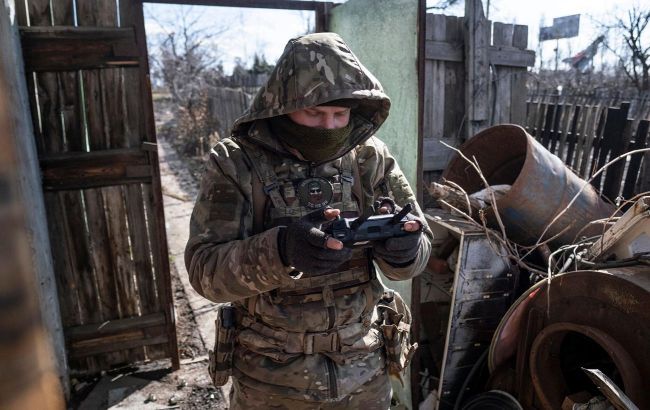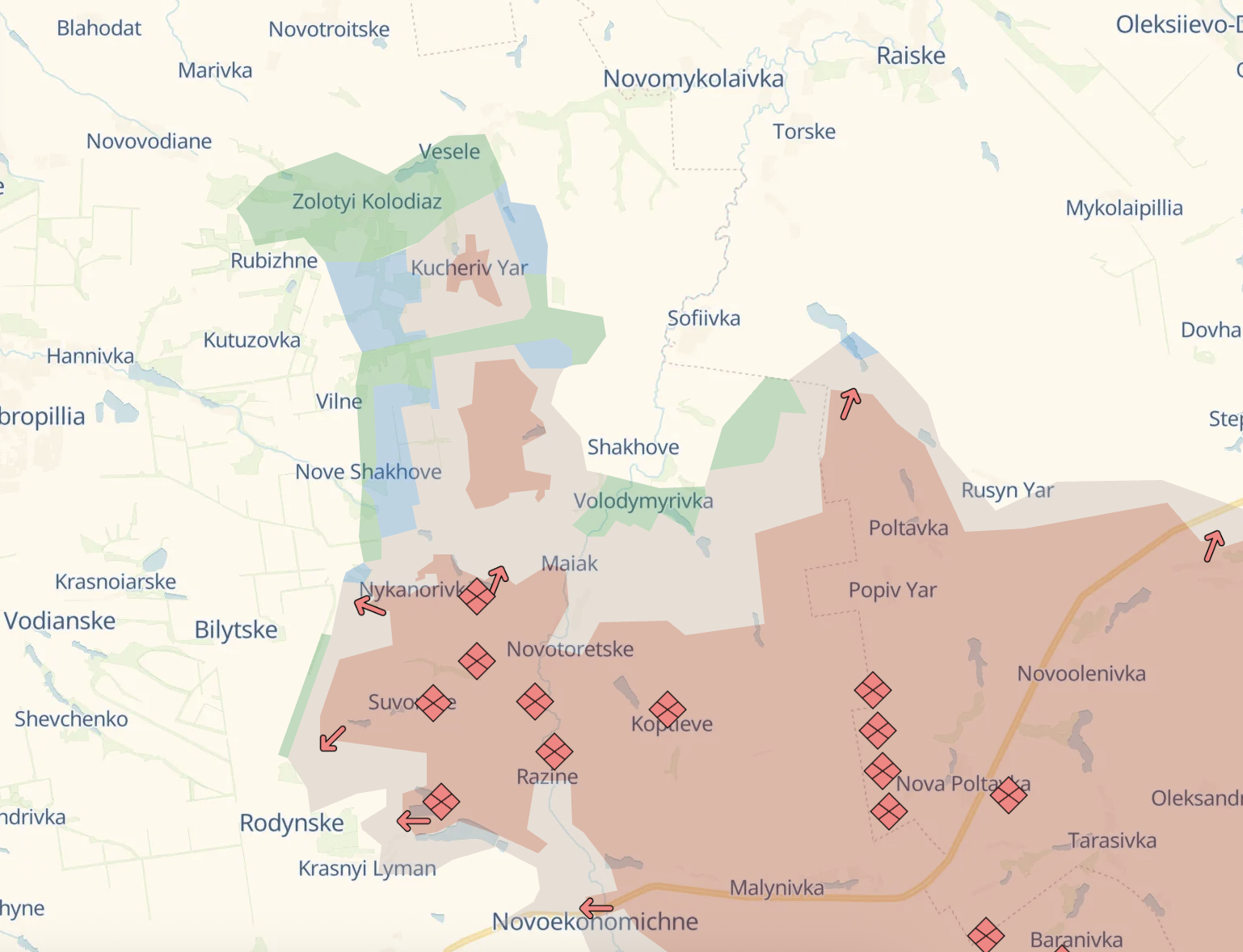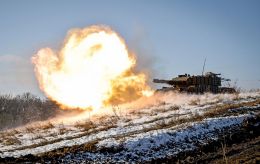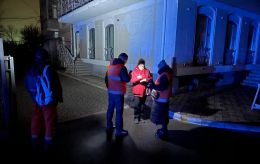Russian autumn offensive: How Ukrainian forces respond to enemy's new tactics
 Ukrainian soldiers are doing their best to hold back the Russian offensive on all sections of the frontline (photo: Facebook, Ukrainian Armed Forces)
Ukrainian soldiers are doing their best to hold back the Russian offensive on all sections of the frontline (photo: Facebook, Ukrainian Armed Forces)
Russian forces continue their slow advance in several directions they consider a priority. Their offense is taking place using new tactics. What is happening on the frontline - read in the report by RBC-Ukraine.
Key questions:
- Which frontline directions are priorities for the Russian forces?
- What is the situation near the Ukrainian cities of Pokrovsk and Kupiansk?
- How do Russian troops manage to continue their advance?
- How the Ukrainian Defense Forces are responding to it?
The Russian autumn campaign on the frontline has every chance of ending with the same result as the spring-summer one. However, claiming that Moscow is doing completely badly on the frontline would also be somewhat unjustified optimism.
Russian forces have achieved success in almost all directions they defined as priorities for the autumn. Still, the scale of their advance is minimal, and the cost is exceptionally high.
Despite broad attempts to capture the entire Donetsk region by the end of this year, according to the latest data from RBC-Ukraine, this deadline for them has been moved to March 2026.
Even these deadlines, given the pace of the enemy's movement and the resistance of Ukrainian troops, do not look realistic. A simple arithmetic calculation shows that if Russia maintains the same rate of advance, it will not be able to capture the entire Donetsk region even by 2027. And this calculation does not take into account factors such as the difficulty of storming urban areas and the counterattacks of Ukrainian forces.
Russian plans
The plans and priorities of the Russian forces on the frontline remain unchanged. And, according to several sources of the publication, they are expected to stay the same during the winter season. One of these priorities is the Pokrovsk area. The Ukrainian Defense Forces carried out successful counteroffensive actions in the Dobropillia area, where, in the summer, Russian forces managed to penetrate more than 10 kilometers into Ukrainian positions.
Sources in military circles explained that the initial Russian plan for this section looked as follows: by the end of September, to extend this tentacle northwest toward Barvinkove, to cut through the northern part of the Donetsk region, and at the same time to expand the flanks of this penetration, moving closer to both Pokrovsk and the Kramatorsk agglomeration. These plans remained only on paper. The weak point for the enemy turned out to be the neck of the Dobropillia salient, where the main fighting broke out. However, as previously predicted by RBC-Ukraine, the Russians sent reinforcements there to prevent their units from being encircled and to push back the Armed Forces of Ukraine.

Black Bird Group map
 DeepState map
DeepState map
Over the past two weeks, the enemy has carried out several mechanized assaults, which have actually become a rare occurrence on the frontline. Armored columns of Russian marines advancing toward Volodymyrivka and Shakhove in an attempt to widen the same neck of the salient were destroyed. Military personnel interviewed by the publication explained that the expansion of this penetration has been stopped, it has been significantly narrowed, but it has not yet been completely cut off.
At the same time, Russian forces are trying to advance directly toward Pokrovsk itself. The most vulnerable area appears to be the southwestern outskirts of the city, from the direction of Leontovychiv and Troyanda. Open-source intelligence (OSINT) analysts indicate that some streets near these villages are already either under Russian control or in the gray zone.
A similar situation is observed in Kupiansk, which is also one of the targets of Moscow's autumn campaign. In September, the enemy managed to infiltrate the city through a gas pipeline, which was later flooded by Ukrainian units. At the same time, the enemy is pressing on Kupiansk from the north. It is still too early to talk about complete stabilization of the situation there; several OSINT observers have recorded Russian soldiers almost in the center of the city.
"The importance of Kupiansk for them lies primarily in the fact that it serves as a logistical route for our grouping on the eastern bank of the Oskil River. Secondly, it provides a convenient bridgehead for an offensive toward Lyman, Siversk, and consequently Sloviansk. And thirdly, there is an informational and political effect — imagine losing again the city that we recaptured in 2022," explained one of RBC-Ukraine's sources.
The enemy is trying to move toward the Kramatorsk agglomeration from the south, approaching Kostiantynivka. An obstacle on its path is that, despite some advances in Toretsk, fighting for the western part of Chasiv Yar continues. This significantly slows down the enemy's plans to encircle Kostiantynivka from the south, east, and northeast.
 The primary focus of the enemy is on capturing the entire Donetsk region from different directions (photo: Getty Images)
The primary focus of the enemy is on capturing the entire Donetsk region from different directions (photo: Getty Images)
Another difficult section remains the Oleksandrivka direction — the junction of the Donetsk, Dnipropetrovsk, and Zaporizhzhia regions (previously known as the Novopavlivka direction). Russian forces have regrouped their troops there and are trying to advance as deep as possible into the Dnipropetrovsk region toward the Zaporizhzhia–Donetsk highway. In September, the enemy managed to capture the most significant area there compared to other sections of the frontline — about 130–140 square kilometers.
"Most of the attention was focused on the Pokrovsk direction. The weak point turned out to be further south — at the junction of the three regions. It's also the boundary between two formations, two groupings. Some may have thought the enemy would reach the Dnipropetrovsk region and stop at the administrative border. Fortunately, the Russian advance there has already slowed down," one of the officers told the publication.
Despite the head of the Russian General Staff, Gerasimov, designating the Zaporizhzhia direction as a priority, there have been no significant changes there so far. Russian forces tried to push toward Stepnohirsk but were eventually driven out.
Instead, a week ago, the Armed Forces of Ukraine conducted their own counteroffensive actions in the Zaporizhzhia region, liberating the settlements of Mali Shcherbaky, Shcherbaky, and partially Stepove. These counteroffensive actions, like some others — for example, near Pokrovsk — were carried out with the participation of assault units, which are now in the process of being established as a separate branch of the military. According to the Commander-in-Chief of the Armed Forces of Ukraine, these units are currently used as rapid reaction forces in the most challenging areas.
Two sources of the publication are convinced that the Russian leadership has not abandoned plans for a more active offensive in the Zaporizhzhia region. However, for now, they are forced to postpone these plans due to the lack of desired results in other areas.
"They do not have enough troops for everything at once. And considering that they are now trying to secure the Donetsk region for themselves, they need to show the greatest progress precisely there. As for the Zaporizhzhia region, it remains secondary for them: 'if they manage to push somewhere — let them,'" one of RBC-Ukraine's sources noted.
New Russian tactics
The continuous Russian advance reflects a change in their tactics, which has been observed in various forms on the frontline for at least the past six months. This infiltration — or seep-through approach — is one of the forms of tactical maneuver. Since the beginning of the year, it has become noticeable that the infantry groups attacking Ukrainian positions have gradually decreased in size. Instead of classic assaults involving 10–20 soldiers, smaller groups advance — sometimes just one, two, or three people — trying to slip unnoticed deep into defensive lines. After a series of such raids, the enemy can accumulate forces and continue operations.
"They undertake long marches — walking several kilometers on foot, moving at night, and trying to hide during the day. One after another, they reach our positions. They go without weapons, carrying food, sometimes with a rifle, slipping past our observation posts," one of the sources described.
The infiltration tactic is a kind of Russian response to the increased use of drones by Ukrainian forces and the growing risks for armored vehicles. Large assault formations are more visible and vulnerable when drones are actively used. The larger the column of equipment, the easier it is to destroy — and the more noticeable a target it becomes.
"I'll say an unpopular opinion, but what helps us respond to such challenges now is literally manual control, because under conditions of limited reserves and constant shortages, there's simply no other way. And of course, the Drone Line and the Unmanned Systems Forces, which also provide improved situational awareness," said one of the soldiers interviewed by RBC-Ukraine.
 UAVs help provide defense and reconnaissance on the frontline (photo: RBC-Ukraine, Vitalii Nosach)
UAVs help provide defense and reconnaissance on the frontline (photo: RBC-Ukraine, Vitalii Nosach)
Drone Line is a project currently subordinated to Unmanned Systems Forces. Broadly speaking, it is the massed and coordinated use of UAVs along the entire frontline: each sector is to be covered by FPV, Maviсs, drop drones, bombers, and recon drones. They operate both in so-called kill zones and in the depths of the enemy's defense.
"This gives excellent results. Unmanned Systems Forces crews attach to a brigade with their assets, and they provide very objective information. When the commander of some corps reports that a village is under our control, Madyar (call sign of Robert Brovdi, commander of a Ukrainian drone unit) says: As of 18:00, we flew over everything, six Russians entered village N, and our nearest positions are at point X And he reports this to the commander-in-chief daily for the whole line, from Kursk to Kherson," the source explains.
From the Russian leadership's point of view, human resources are more available and not as valuable as equipment. And as long as their recruitment plans for contract soldiers are fully implemented, they will use those personnel to cut through Ukrainian defensive lines.
"Sometimes, even a single soldier may go. And like that — one by one — about 60 of them may appear over a week. When suddenly someone starts shooting at our troops from behind or from the side, panic naturally begins on the ground. Sometimes they bring 2–3 mines with them to lay at a crossroads. They advance and wait for reinforcements or replacement, because they are promised to be rotated in 2–3 days. But a week passes, and they can no longer go back or forward. Some of them have already been pulled out from that Zolotyi Kolodyaz for two months now," one of the officers said, recalling Russian infiltration near Dobropillia.
Such a tactic does not allow for operational breakthroughs, and there are serious doubts about how effective it can be in the winter period, since it will become harder for Russian "walkers" to hide in forest belts under the cover of greenery and leaves. Perhaps this is why the enemy has attempted to resume mechanized assaults, such as those carried out in the Dobropillia direction.
In any case, without a mechanized component, the enemy is unlikely to achieve operational space, let alone a significant breakthrough on the frontline. Forming the same kind of strike fist as the 155th Russian Guards Naval Infantry Brigade attempted near Vuhledar, or a column of several dozen vehicles like during the offensive on Avdiivka, no longer seems a routine task for them. Therefore, as the publication's sources predict, in the near future, the enemy will likely try to strike at Ukrainian frontline logistics and put pressure wherever they manage to advance. But all of these points point to a war of attrition, while Moscow tries to arrange negotiation cards in a combination favorable to itself.

